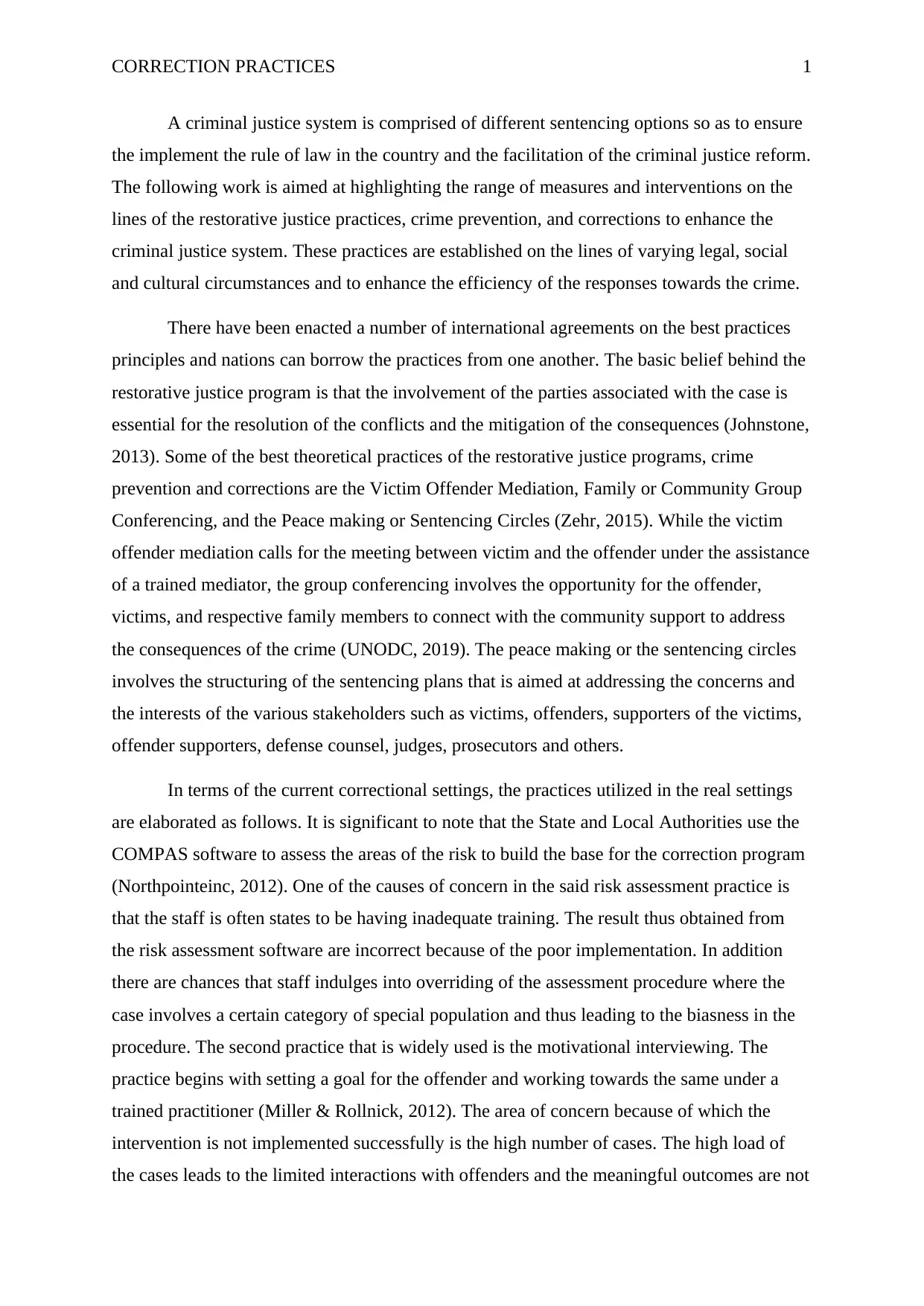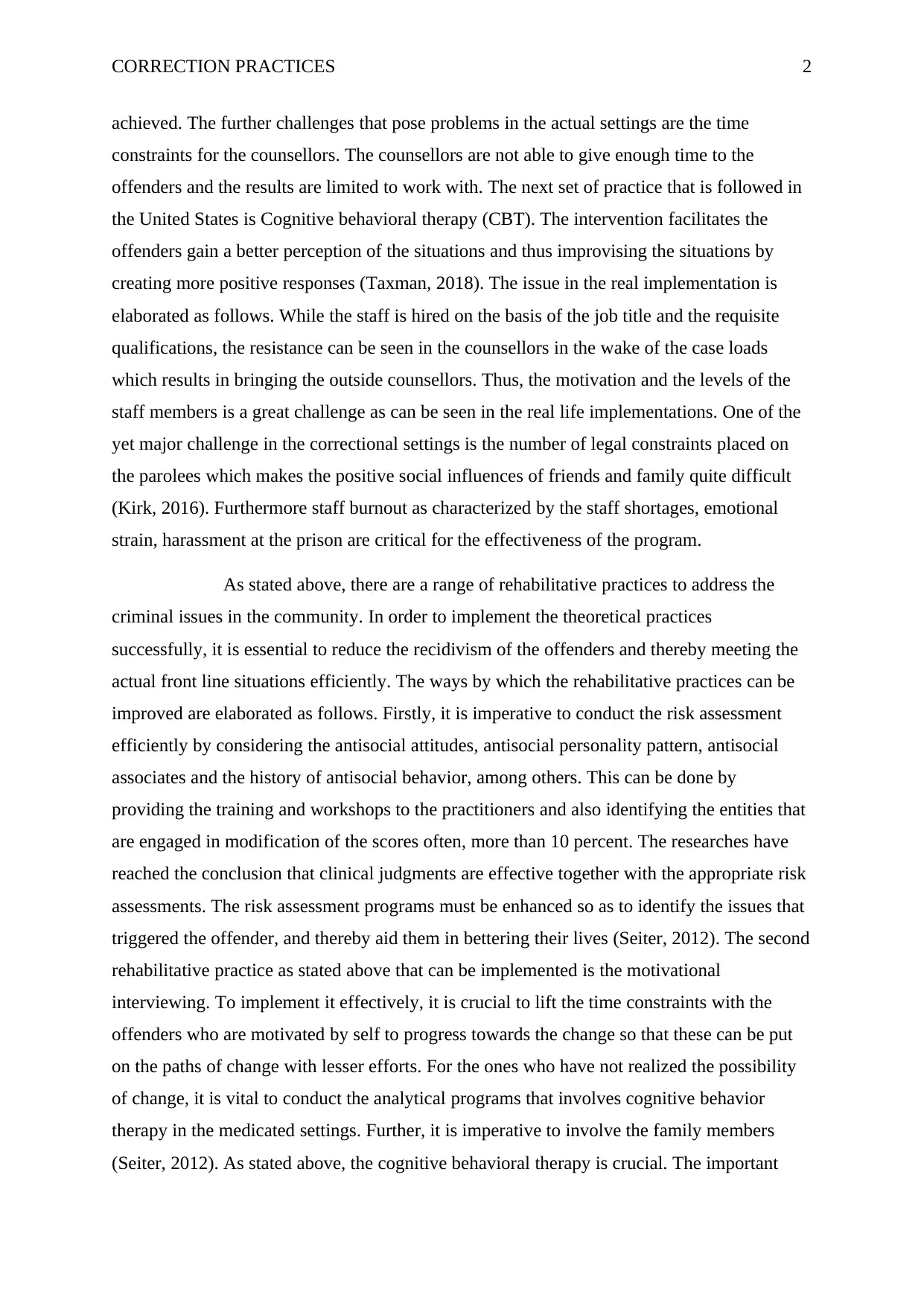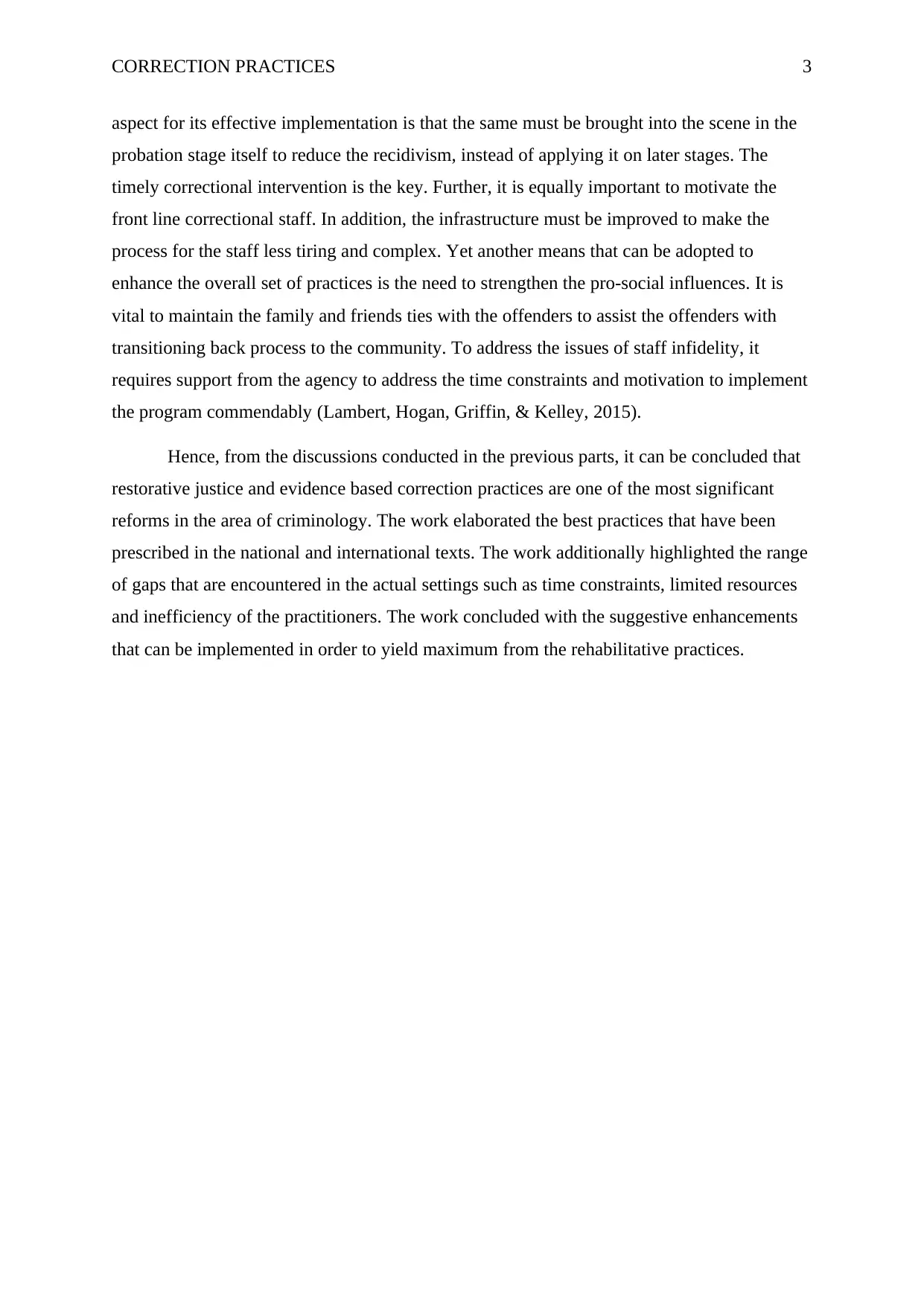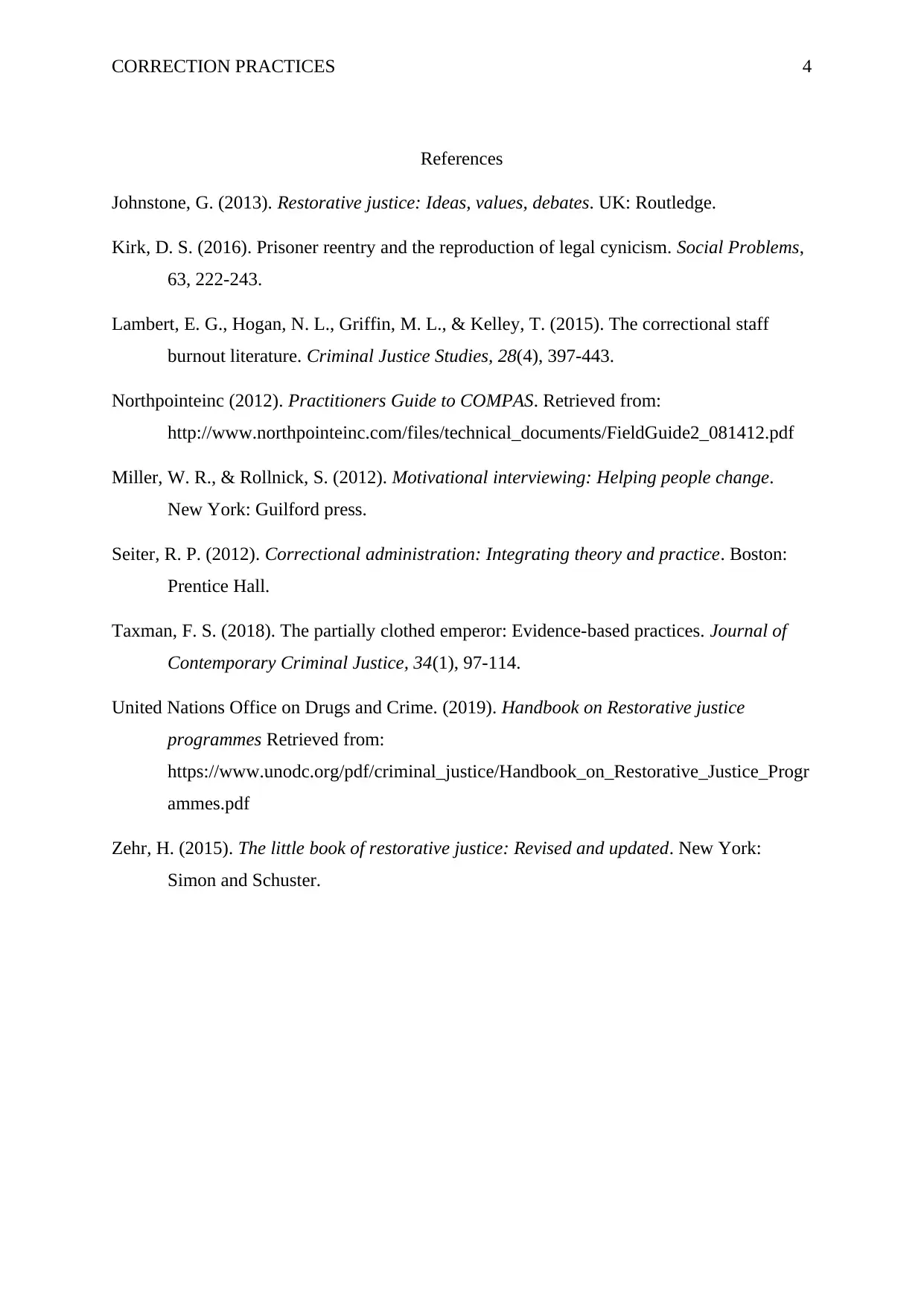Criminal Justice: Comparing Theory and Practice in Corrections
VerifiedAdded on 2022/11/26
|5
|1535
|52
Report
AI Summary
This report delves into the realm of criminal justice, focusing on restorative justice, crime prevention, and correctional practices. It begins by outlining theoretical best practices, such as Victim Offender Mediation, Family or Community Group Conferencing, and Peace making or Sentencing Circles. The report then examines how these theoretical practices are, and are not, implemented in current correctional settings in the United States, highlighting the use of COMPAS software, motivational interviewing, and Cognitive Behavioral Therapy (CBT). The analysis reveals challenges such as inadequate staff training, high caseloads, and legal constraints on parolees. The report concludes by proposing ways to improve rehabilitative services, emphasizing efficient risk assessment, lifting time constraints, integrating CBT early, motivating staff, strengthening pro-social influences, and strengthening ties with family and friends.

CRIMINAL LAW
CORRECTIONS
CORRECTIONS
Paraphrase This Document
Need a fresh take? Get an instant paraphrase of this document with our AI Paraphraser

CORRECTION PRACTICES 1
A criminal justice system is comprised of different sentencing options so as to ensure
the implement the rule of law in the country and the facilitation of the criminal justice reform.
The following work is aimed at highlighting the range of measures and interventions on the
lines of the restorative justice practices, crime prevention, and corrections to enhance the
criminal justice system. These practices are established on the lines of varying legal, social
and cultural circumstances and to enhance the efficiency of the responses towards the crime.
There have been enacted a number of international agreements on the best practices
principles and nations can borrow the practices from one another. The basic belief behind the
restorative justice program is that the involvement of the parties associated with the case is
essential for the resolution of the conflicts and the mitigation of the consequences (Johnstone,
2013). Some of the best theoretical practices of the restorative justice programs, crime
prevention and corrections are the Victim Offender Mediation, Family or Community Group
Conferencing, and the Peace making or Sentencing Circles (Zehr, 2015). While the victim
offender mediation calls for the meeting between victim and the offender under the assistance
of a trained mediator, the group conferencing involves the opportunity for the offender,
victims, and respective family members to connect with the community support to address
the consequences of the crime (UNODC, 2019). The peace making or the sentencing circles
involves the structuring of the sentencing plans that is aimed at addressing the concerns and
the interests of the various stakeholders such as victims, offenders, supporters of the victims,
offender supporters, defense counsel, judges, prosecutors and others.
In terms of the current correctional settings, the practices utilized in the real settings
are elaborated as follows. It is significant to note that the State and Local Authorities use the
COMPAS software to assess the areas of the risk to build the base for the correction program
(Northpointeinc, 2012). One of the causes of concern in the said risk assessment practice is
that the staff is often states to be having inadequate training. The result thus obtained from
the risk assessment software are incorrect because of the poor implementation. In addition
there are chances that staff indulges into overriding of the assessment procedure where the
case involves a certain category of special population and thus leading to the biasness in the
procedure. The second practice that is widely used is the motivational interviewing. The
practice begins with setting a goal for the offender and working towards the same under a
trained practitioner (Miller & Rollnick, 2012). The area of concern because of which the
intervention is not implemented successfully is the high number of cases. The high load of
the cases leads to the limited interactions with offenders and the meaningful outcomes are not
A criminal justice system is comprised of different sentencing options so as to ensure
the implement the rule of law in the country and the facilitation of the criminal justice reform.
The following work is aimed at highlighting the range of measures and interventions on the
lines of the restorative justice practices, crime prevention, and corrections to enhance the
criminal justice system. These practices are established on the lines of varying legal, social
and cultural circumstances and to enhance the efficiency of the responses towards the crime.
There have been enacted a number of international agreements on the best practices
principles and nations can borrow the practices from one another. The basic belief behind the
restorative justice program is that the involvement of the parties associated with the case is
essential for the resolution of the conflicts and the mitigation of the consequences (Johnstone,
2013). Some of the best theoretical practices of the restorative justice programs, crime
prevention and corrections are the Victim Offender Mediation, Family or Community Group
Conferencing, and the Peace making or Sentencing Circles (Zehr, 2015). While the victim
offender mediation calls for the meeting between victim and the offender under the assistance
of a trained mediator, the group conferencing involves the opportunity for the offender,
victims, and respective family members to connect with the community support to address
the consequences of the crime (UNODC, 2019). The peace making or the sentencing circles
involves the structuring of the sentencing plans that is aimed at addressing the concerns and
the interests of the various stakeholders such as victims, offenders, supporters of the victims,
offender supporters, defense counsel, judges, prosecutors and others.
In terms of the current correctional settings, the practices utilized in the real settings
are elaborated as follows. It is significant to note that the State and Local Authorities use the
COMPAS software to assess the areas of the risk to build the base for the correction program
(Northpointeinc, 2012). One of the causes of concern in the said risk assessment practice is
that the staff is often states to be having inadequate training. The result thus obtained from
the risk assessment software are incorrect because of the poor implementation. In addition
there are chances that staff indulges into overriding of the assessment procedure where the
case involves a certain category of special population and thus leading to the biasness in the
procedure. The second practice that is widely used is the motivational interviewing. The
practice begins with setting a goal for the offender and working towards the same under a
trained practitioner (Miller & Rollnick, 2012). The area of concern because of which the
intervention is not implemented successfully is the high number of cases. The high load of
the cases leads to the limited interactions with offenders and the meaningful outcomes are not

CORRECTION PRACTICES 2
achieved. The further challenges that pose problems in the actual settings are the time
constraints for the counsellors. The counsellors are not able to give enough time to the
offenders and the results are limited to work with. The next set of practice that is followed in
the United States is Cognitive behavioral therapy (CBT). The intervention facilitates the
offenders gain a better perception of the situations and thus improvising the situations by
creating more positive responses (Taxman, 2018). The issue in the real implementation is
elaborated as follows. While the staff is hired on the basis of the job title and the requisite
qualifications, the resistance can be seen in the counsellors in the wake of the case loads
which results in bringing the outside counsellors. Thus, the motivation and the levels of the
staff members is a great challenge as can be seen in the real life implementations. One of the
yet major challenge in the correctional settings is the number of legal constraints placed on
the parolees which makes the positive social influences of friends and family quite difficult
(Kirk, 2016). Furthermore staff burnout as characterized by the staff shortages, emotional
strain, harassment at the prison are critical for the effectiveness of the program.
As stated above, there are a range of rehabilitative practices to address the
criminal issues in the community. In order to implement the theoretical practices
successfully, it is essential to reduce the recidivism of the offenders and thereby meeting the
actual front line situations efficiently. The ways by which the rehabilitative practices can be
improved are elaborated as follows. Firstly, it is imperative to conduct the risk assessment
efficiently by considering the antisocial attitudes, antisocial personality pattern, antisocial
associates and the history of antisocial behavior, among others. This can be done by
providing the training and workshops to the practitioners and also identifying the entities that
are engaged in modification of the scores often, more than 10 percent. The researches have
reached the conclusion that clinical judgments are effective together with the appropriate risk
assessments. The risk assessment programs must be enhanced so as to identify the issues that
triggered the offender, and thereby aid them in bettering their lives (Seiter, 2012). The second
rehabilitative practice as stated above that can be implemented is the motivational
interviewing. To implement it effectively, it is crucial to lift the time constraints with the
offenders who are motivated by self to progress towards the change so that these can be put
on the paths of change with lesser efforts. For the ones who have not realized the possibility
of change, it is vital to conduct the analytical programs that involves cognitive behavior
therapy in the medicated settings. Further, it is imperative to involve the family members
(Seiter, 2012). As stated above, the cognitive behavioral therapy is crucial. The important
achieved. The further challenges that pose problems in the actual settings are the time
constraints for the counsellors. The counsellors are not able to give enough time to the
offenders and the results are limited to work with. The next set of practice that is followed in
the United States is Cognitive behavioral therapy (CBT). The intervention facilitates the
offenders gain a better perception of the situations and thus improvising the situations by
creating more positive responses (Taxman, 2018). The issue in the real implementation is
elaborated as follows. While the staff is hired on the basis of the job title and the requisite
qualifications, the resistance can be seen in the counsellors in the wake of the case loads
which results in bringing the outside counsellors. Thus, the motivation and the levels of the
staff members is a great challenge as can be seen in the real life implementations. One of the
yet major challenge in the correctional settings is the number of legal constraints placed on
the parolees which makes the positive social influences of friends and family quite difficult
(Kirk, 2016). Furthermore staff burnout as characterized by the staff shortages, emotional
strain, harassment at the prison are critical for the effectiveness of the program.
As stated above, there are a range of rehabilitative practices to address the
criminal issues in the community. In order to implement the theoretical practices
successfully, it is essential to reduce the recidivism of the offenders and thereby meeting the
actual front line situations efficiently. The ways by which the rehabilitative practices can be
improved are elaborated as follows. Firstly, it is imperative to conduct the risk assessment
efficiently by considering the antisocial attitudes, antisocial personality pattern, antisocial
associates and the history of antisocial behavior, among others. This can be done by
providing the training and workshops to the practitioners and also identifying the entities that
are engaged in modification of the scores often, more than 10 percent. The researches have
reached the conclusion that clinical judgments are effective together with the appropriate risk
assessments. The risk assessment programs must be enhanced so as to identify the issues that
triggered the offender, and thereby aid them in bettering their lives (Seiter, 2012). The second
rehabilitative practice as stated above that can be implemented is the motivational
interviewing. To implement it effectively, it is crucial to lift the time constraints with the
offenders who are motivated by self to progress towards the change so that these can be put
on the paths of change with lesser efforts. For the ones who have not realized the possibility
of change, it is vital to conduct the analytical programs that involves cognitive behavior
therapy in the medicated settings. Further, it is imperative to involve the family members
(Seiter, 2012). As stated above, the cognitive behavioral therapy is crucial. The important
⊘ This is a preview!⊘
Do you want full access?
Subscribe today to unlock all pages.

Trusted by 1+ million students worldwide

CORRECTION PRACTICES 3
aspect for its effective implementation is that the same must be brought into the scene in the
probation stage itself to reduce the recidivism, instead of applying it on later stages. The
timely correctional intervention is the key. Further, it is equally important to motivate the
front line correctional staff. In addition, the infrastructure must be improved to make the
process for the staff less tiring and complex. Yet another means that can be adopted to
enhance the overall set of practices is the need to strengthen the pro-social influences. It is
vital to maintain the family and friends ties with the offenders to assist the offenders with
transitioning back process to the community. To address the issues of staff infidelity, it
requires support from the agency to address the time constraints and motivation to implement
the program commendably (Lambert, Hogan, Griffin, & Kelley, 2015).
Hence, from the discussions conducted in the previous parts, it can be concluded that
restorative justice and evidence based correction practices are one of the most significant
reforms in the area of criminology. The work elaborated the best practices that have been
prescribed in the national and international texts. The work additionally highlighted the range
of gaps that are encountered in the actual settings such as time constraints, limited resources
and inefficiency of the practitioners. The work concluded with the suggestive enhancements
that can be implemented in order to yield maximum from the rehabilitative practices.
aspect for its effective implementation is that the same must be brought into the scene in the
probation stage itself to reduce the recidivism, instead of applying it on later stages. The
timely correctional intervention is the key. Further, it is equally important to motivate the
front line correctional staff. In addition, the infrastructure must be improved to make the
process for the staff less tiring and complex. Yet another means that can be adopted to
enhance the overall set of practices is the need to strengthen the pro-social influences. It is
vital to maintain the family and friends ties with the offenders to assist the offenders with
transitioning back process to the community. To address the issues of staff infidelity, it
requires support from the agency to address the time constraints and motivation to implement
the program commendably (Lambert, Hogan, Griffin, & Kelley, 2015).
Hence, from the discussions conducted in the previous parts, it can be concluded that
restorative justice and evidence based correction practices are one of the most significant
reforms in the area of criminology. The work elaborated the best practices that have been
prescribed in the national and international texts. The work additionally highlighted the range
of gaps that are encountered in the actual settings such as time constraints, limited resources
and inefficiency of the practitioners. The work concluded with the suggestive enhancements
that can be implemented in order to yield maximum from the rehabilitative practices.
Paraphrase This Document
Need a fresh take? Get an instant paraphrase of this document with our AI Paraphraser

CORRECTION PRACTICES 4
References
Johnstone, G. (2013). Restorative justice: Ideas, values, debates. UK: Routledge.
Kirk, D. S. (2016). Prisoner reentry and the reproduction of legal cynicism. Social Problems,
63, 222-243.
Lambert, E. G., Hogan, N. L., Griffin, M. L., & Kelley, T. (2015). The correctional staff
burnout literature. Criminal Justice Studies, 28(4), 397-443.
Northpointeinc (2012). Practitioners Guide to COMPAS. Retrieved from:
http://www.northpointeinc.com/files/technical_documents/FieldGuide2_081412.pdf
Miller, W. R., & Rollnick, S. (2012). Motivational interviewing: Helping people change.
New York: Guilford press.
Seiter, R. P. (2012). Correctional administration: Integrating theory and practice. Boston:
Prentice Hall.
Taxman, F. S. (2018). The partially clothed emperor: Evidence-based practices. Journal of
Contemporary Criminal Justice, 34(1), 97-114.
United Nations Office on Drugs and Crime. (2019). Handbook on Restorative justice
programmes Retrieved from:
https://www.unodc.org/pdf/criminal_justice/Handbook_on_Restorative_Justice_Progr
ammes.pdf
Zehr, H. (2015). The little book of restorative justice: Revised and updated. New York:
Simon and Schuster.
References
Johnstone, G. (2013). Restorative justice: Ideas, values, debates. UK: Routledge.
Kirk, D. S. (2016). Prisoner reentry and the reproduction of legal cynicism. Social Problems,
63, 222-243.
Lambert, E. G., Hogan, N. L., Griffin, M. L., & Kelley, T. (2015). The correctional staff
burnout literature. Criminal Justice Studies, 28(4), 397-443.
Northpointeinc (2012). Practitioners Guide to COMPAS. Retrieved from:
http://www.northpointeinc.com/files/technical_documents/FieldGuide2_081412.pdf
Miller, W. R., & Rollnick, S. (2012). Motivational interviewing: Helping people change.
New York: Guilford press.
Seiter, R. P. (2012). Correctional administration: Integrating theory and practice. Boston:
Prentice Hall.
Taxman, F. S. (2018). The partially clothed emperor: Evidence-based practices. Journal of
Contemporary Criminal Justice, 34(1), 97-114.
United Nations Office on Drugs and Crime. (2019). Handbook on Restorative justice
programmes Retrieved from:
https://www.unodc.org/pdf/criminal_justice/Handbook_on_Restorative_Justice_Progr
ammes.pdf
Zehr, H. (2015). The little book of restorative justice: Revised and updated. New York:
Simon and Schuster.
1 out of 5
Related Documents
Your All-in-One AI-Powered Toolkit for Academic Success.
+13062052269
info@desklib.com
Available 24*7 on WhatsApp / Email
![[object Object]](/_next/static/media/star-bottom.7253800d.svg)
Unlock your academic potential
Copyright © 2020–2025 A2Z Services. All Rights Reserved. Developed and managed by ZUCOL.





